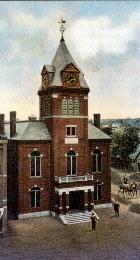Newport Opera House

Our first Town Hall was built in 1872. Destroyed by fire in 1885, it was rebuilt in 1886 by Hiram Beckwith of Claremont at a cost of $26,000. The walls are 16" thick on the first floor and 12" thick on the second floor. It is also our Court House and our Opera House.
In 1887, a chandelier for the main hall was purchased. It later disappeared, then resurfaced, and once again lights the main hall. The windows have three sliding shutters topped by leaded stained glass. In 1904, a 3-story stage was added, along with extensive electrical equipment and was referred to as “the largest stage north of Boston.” Directly beneath the stage were 11 dressing rooms. In 1913, two 3-globe lampposts were set in front of the Opera House, the model for today's vintage lighting on Main Street.
During 1950-60, activity slowed as the facility aged, but in 1974 the Opera House Association formed to promote performing arts, and made major contributions to the facility, including upholstered seats. Until 1976, deacons benches were used on the main floor, with balcony seating about 200. The hall capacity permitted today is 250-300 for a dance and 675 for an assembly.
In 1980, the building was listed on the National Register of Historic Places. Throughout the years, the Town Hall has been the center of community events. The town continues to invest in major renovations for the upkeep of this valuable historic public facility.
[Source: Opera House Association]

